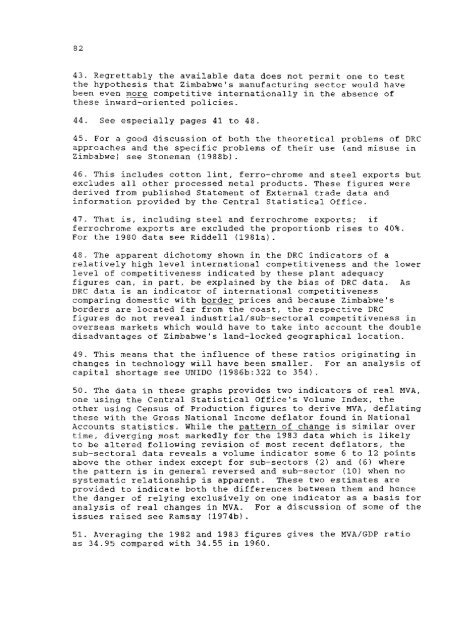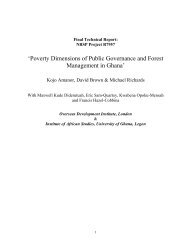Zimbabwe - Overseas Development Institute
Zimbabwe - Overseas Development Institute
Zimbabwe - Overseas Development Institute
Create successful ePaper yourself
Turn your PDF publications into a flip-book with our unique Google optimized e-Paper software.
43. Regrettably the a v a i l a b l e data does not permit one to t e s t<br />
the hypothesis that <strong>Zimbabwe</strong>'s manufacturing sector would have<br />
been even more competitive i n t e r n a t i o n a l l y i n the absence of<br />
these inward-oriented p o l i c i e s .<br />
44. See e s p e c i a l l y pages 41 to 48.<br />
45. For a good d i s c u s s i o n of both the t h e o r e t i c a l problems of DRC<br />
approaches and the s p e c i f i c problems of t h e i r use (and misuse i n<br />
<strong>Zimbabwe</strong>) see Stoneman (1988b>.<br />
46. This includes cotton l i n t , ferro-chrome and s t e e l exports but<br />
excludes a l l other processed metal products. These f i g u r e s were<br />
derived from published Statement of External trade data and<br />
information provided by the Central S t a t i s t i c a l O f f i c e .<br />
47. That i s , i n c l u d i n g s t e e l and ferrochrome exports; i f<br />
ferrochrome exports are excluded the proportionb r i s e s to 40%.<br />
For the 1980 data see R i d d e l l (1981a).<br />
48. The apparent dichotomy shown i n the DRC i n d i c a t o r s of a<br />
r e l a t i v e l y high l e v e l i n t e r n a t i o n a l competitiveness and the lower<br />
l e v e l of competitiveness i n d i c a t e d by these plant adequacy<br />
f i g u r e s can, i n part, be explained by the bias of DRC data. As<br />
DRC data i s an i n d i c a t o r of i n t e r n a t i o n a l competitiveness<br />
comparing domestic with border p r i c e s and because <strong>Zimbabwe</strong>'s<br />
borders are located f a r from the coast, the r e s p e c t i v e DRC<br />
f i g u r e s do not r e v e a l i n d u s t r i a l / s u b - s e c t o r a l competitiveness i n<br />
overseas markets which would have to take i n t o account the double<br />
disadvantages of <strong>Zimbabwe</strong>'s land-locked geographical l o c a t i o n .<br />
49. This means that the i n f l u e n c e of these r a t i o s o r i g i n a t i n g i n<br />
changes i n technology w i l l have been smaller. For an a n a l y s i s of<br />
c a p i t a l shortage see UNIDO (1986b:322 to 354).<br />
50. The data i n these graphs provides two i n d i c a t o r s of r e a l MVA,<br />
one using the Central S t a t i s t i c a l O f f i c e ' s Volume Index, the<br />
other using Census of Production f i g u r e s to derive MVA, d e f l a t i n g<br />
these with the Gross National Income d e f l a t o r found i n National<br />
Accounts s t a t i s t i c s . While the pattern of change i s s i m i l a r over<br />
time, d i v e r g i n g most markedly f o r the 1983 data which i s l i k e l y<br />
to be a l t e r e d f o l l o w i n g r e v i s i o n of most recent d e f l a t o r s , the<br />
sub-sectoral data reveals a volume i n d i c a t o r some 6 to 12 points<br />
above the other index except f o r sub-sectors (2) and (6) where<br />
the p a t t e r n i s i n general reversed and sub-sector (10) when no<br />
systematic r e l a t i o n s h i p i s apparent. These two estimates are<br />
provided to i n d i c a t e both the d i f f e r e n c e s between them and hence<br />
the danger of r e l y i n g e x c l u s i v e l y on one i n d i c a t o r as a basis f o r<br />
a n a l y s i s of r e a l changes i n MVA. For a d i s c u s s i o n of some of the<br />
issues r a i s e d see Ramsay (1974b).<br />
51. Averaging the 1982 and 1983 f i g u r e s gives the MVA/GDP r a t i o<br />
as 34.95 compared with 34.55 i n 1960.
















